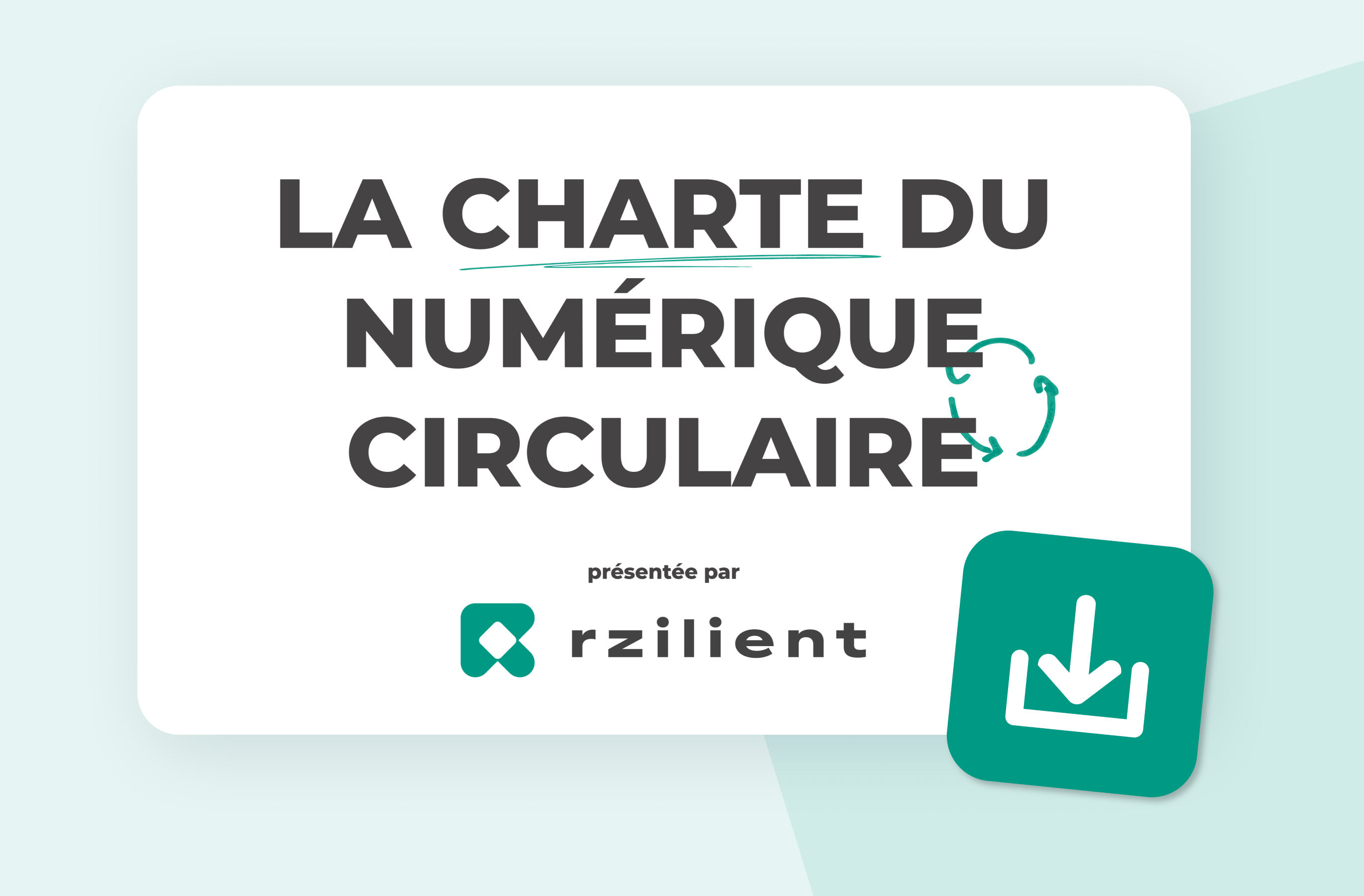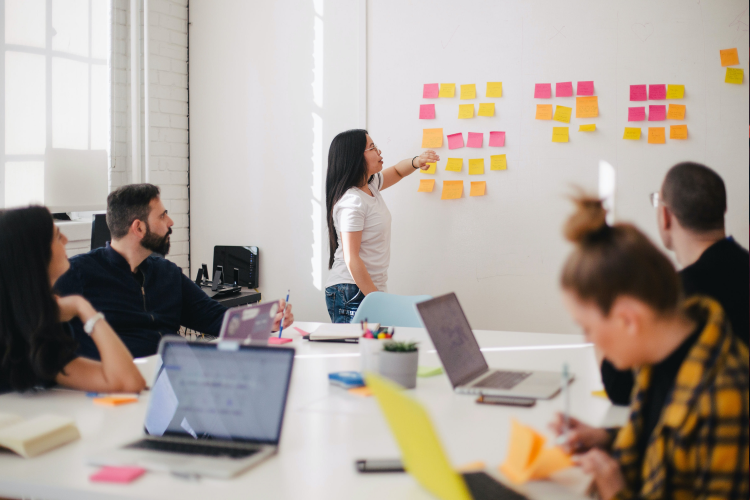Partners: the foundation of the circular economy

Discover our all-in-one solution
On June 29, 2021, a Symposium on the circular economy was held at ESCP. The French Association of Enterprises for the Environment (EpE) exhibited there 3 years of reflection carried out by its “Natural Resources” commission on The circular economy approach.
This collective reflection, conducted under the chairmanship of Rachel Kolbe Semhoun, CSR director of the InVivo group, was based on 27 concrete steps carried out by various companies. From this analysis, it emerged:
- The main objectives of the circular economy;
- the analysis of the diversity of main governance models ;
- the different ways to implement it;
- The importance of partnerships to co-build a stable and sustainable model.
How to successfully implement a circular economy? What is the place and The role of partnerships ? Rzilient gives you some ideas for thought and presents its eco-collaborations for a virtuous digital sector.
What is the circular economy?
Today, it is important to find alternative models to try to extract fewer rare resources, use less energy, and produce less waste.
The circular economy appears as a good solution since it is presented as a alternative model to the dominant economic model which is based on the linear use of raw materials.
According to ADEME, the circular diagram is a exchange and production system that seeks to increase the efficiency of the use of resources and reduce the impact on the environment. The carbon footprint of the company and users is reduced, which makes it possible to reduce the carbon footprint of digital technology.
To be beneficial, Rzilient base its circular economic model on 3 main areas:
- The offer : we buy a service more than material goods;
- The Demand and behavior consumers: the challenge is to extend the lifespan of their digital tools as much as possible;
- The waste management.
Even though this circular economic model seems to be the ideal solution for the next few years to come, there are numerous obstacles to its implementation.
The obstacles and constraints of the circular model
The dispersion of secondary material deposits
Sometimes the energy and secondary materials needed to make a raw resource are Scattered everywhere on the territory. It can be costly (in terms of time, energy, and money) to collect and put them together. The example of microplastics In the oceans, speaking of course, it is almost impossible to collect them because of their size and quantity.
There is also a big lack of access to information on these deposits of secondary materials. This is a real obstacle to their collection and reintegration into the economy.
To speed up the process, the following information should be provided:
- The geolocation deposits;
- The quantity and quality ;
- The actors of the sector.
Variable quantity and quality
Depending on the secondary materials you need, there may be an increase in demand, which results in a rarefaction of the material. Materials that are recyclable are often produced in insufficient quantities to cover all needs. It is then necessary to produce something new.
Iron is a good example. It is easy to recycle and recover it, this is the case for 95% of scrap. But only 40% of steel production comes from recycling because the total quantities requested are increasing.
La Quality is also a variable factor which can quickly become a constraint. Often mixed with other materials, secondary raw materials are sometimes of lower quality than new raw materials.

The lack of technology
We are still in the early stages of the circular economy. Some technologies are missing to be able to help the model be deployed at scale. Price is also a barrier since new raw materials are often cheaper because they do not require sorting, recycling, dissociation compounds.
In the digital sector, it is very difficult to recycle components because of their small size and the missing technologies to do so in a major way.
Lack of access to information
To develop this circular diagram, we need:
- technical expertise
- of scientific knowledge
- organizational expertise.
The work can be long and complex and the lack of information on the subject, or even training, is an obstacle to its massive development.
The lack of an incentive regulatory and fiscal framework
Public policies are beginning to become aware of the extent of environmental challenges and are implementing favorable regulations.
For example, there is the anti-waste law for a circular economy (AGEC), which dates from February 10, 2020, and other discussion projects on the circular economy. But businesses are complaining the absence or delay of certain legislations and especially the lack of a global incentive framework.
It can be seen that some refurbished equipment or secondary raw materials are more expensive than traditional alternatives, which does not encourage businesses to take up the issue.
The persistence of psychological barriers
One of the big black spots for getting out of a traditional pattern and adopting the circular economy are psychological blockages. In business, some people may perceive it as an obstacle to the development of the activity, while others are simply reluctant to change their habits.
It can also be difficult to get out of the idea that it is necessary to always have The latest trendy product and that refurbished computer tools are of lower quality than new ones.

No circular economy without partners
To get around these various obstacles, it is the need to build partnerships.
The latter can be:
- Of public authorities ;
- Of associations ;
- Of research institutes ;
- Others undertakings.
The 3 modes of governance
To link eco-partnerships in order to create a circular economy within your company, there are 3 ways to work together:
- Governance centralized ;
- Governance distributed ;
- governance in the form of digital platform.
- Centralized governance
Governance between the various partners is mainly carried out by A single actor who takes care of the process.
It is he who takes on most of the organizational costs and risks. In return, he is also the one who shoots The most benefits of all the partnerships established.
- Distributed governance
Distributed governance between partners in a circular economy is fairer. It is based on a pattern of equal sharing of costs, risks and benefits.
- Governance in the form of a digital platform
This type of governance is based less on proximity, but rather on efficiency. Partners are put in contact on a platform that highlights new opportunities for commercial transactions between the actors.
The objectives of partnerships in the circular economy
Making the most of local resources
To do this, the partners are trying to answer the question: How to take advantage of your immediate environment, neighboring agricultural or industrial activities? For example, businesses can partner so that one person's waste becomes another person's energy.
Securing supplies and outlets
Reflect on local alliances makes it possible to reduce waste, but above all, to secure its raw materials. Thanks to these cross-commitments, the partners are creating closed loops of value.
The difficulties associated with the variation in the flow of secondary raw materials no longer exist since businesses no longer depend on exogenous factors but on local businesses with whom they have created alliances.
Structuring circular economy sectors
Creating these economy loops allows you to see The missing links. Businesses can be created to meet this need in order to limit waste. The economy is viable in the long term thanks to an increasing number of players.
Experiment and industrialize
As we have seen, what is holding back massive development is the lack of knowledge and technology. Building partners makes it possible to sharing costs of technological exploration; the investment of a single player is less than that of several.
Creating new value chains
Collaborations have the possibility of to be created on a national or continental scale. It is the best way to profoundly transform certain sectors of activity. All the more so if the players in this economic model are supported by public authorities, manufacturers and players in the world of research.

A circular digital sector thanks to Rzilient's eco-partners
Partners create a virtuous and more resilient circular system. This is in particular the wish of Rzilient in the digital sector, which takes care of the computer equipment of its partner companies, for example.
The main objective of Rzilient: to do that theThe corporate fleet process is becoming a convenience by recreating links between the various players in the responsible digital sector.
Actors in the digital value chain
Reconditioners, suppliers and repairers
Collaborations are numerous, we work especially with actors involved in the reconditioning and repair of the following computer devices:
- YesYes ;
- Okamac ;
- Destock info ;
- Olinn distribution ;
- Ecodair ;
- Save Market ;
- LM Eco ;
- Agora Place ;
- Keyboard key ;
- iCare.
Establishing partnerships makes it possible to Get out of the simple supplier relationship because we are working on the long term on the co-design of services integrated into the platform developed by Rzilient in order to simplify and standardize sustainable procurement and repair processes.
In addition, in an effort to ensure consistency, we are doing our best to operate in Short circuit. We therefore work with reconditioners in France and Europe in order to reduce the distances between their workshops and our customers. In this context, for low-carbon delivery, we collaborate with:
Our customers/users
Today, there are about a hundred of them. The new forms of contracts signed by both parties are thus based on the performance And theusage, not ownership, through an approach of services offered by Rzilient throughout the life cycle of the digital devices offered. In particular, we are proud to support the following players:
- Inspeer ;
- Pure Project ;
- Greengo Consignment ;
- Stewardship ;
- Lemon Tri ;
- Kippit ;
- Circul'r ;
- Circulab ;
- Carbometrix.
We thus partner with committed projects in order to help them maximize their impact societal. Supporting projects that share common values in order to transform the business world is our raison d'être.
Actors at the end of the life of the equipment
When the equipment cannot be refurbished, we work in particular with 3 players in the sector in addition to our reconditioners:
The work is done Hand in hand with real complementarity of approaches in the respective value chains. The challenge is to maximizing the residual value “end of cycle” equipment when the customer separates it.
Partners who calculate the carbon footprint
To reduce its environmental impact, Rzilient offers the possibility of renting its services and refurbished equipment. It's coming complete initiatives to reduce its carbon footprint, hence the eco-collaborations with Greenly, sami and Keewe.
Responsible digital players
To have a truly responsible and virtuous digital sector, you must create complementarities. That is why we are working together with FileVert and Canopé.
The first intervenes at the level of uses of digital technology while the second focuses on awareness-raising and training workshops, all in order to support more sustainable digital practices. Rzilient comes as a concrete solution to support equipment management.
Eco-responsibility in the office
A tripartite collaboration is set up with Adopt a desk and AkaGreen to introduce moreeco-responsibility in the office. The solutions are complementary and intervene at different levels in order to cultivate more wellness at work - AkaGreen by greening workspaces to reconnect with nature, Adopts an office by providing pleasant and sustainable furniture to reduce its environmental impact, and Rzilient by promoting digital technology with a positive impact in order to put responsible and circular practices back at the center of the digital approach of businesses.
Collaborations between committed actors
We also collaborate with platforms for referencing responsible projects as well as sustainable media in order to engage a dialogue about our common topics and give them more visibility among the general public:
Platforms for referencing responsible projects
Sustainable media partners
Whether for SEO platforms or sustainable media partners, our collaborations make it possible to feed their databases, which in turn increases our visibility and legitimacy. This also feeds our SEO so that we are referenced and recognized by companies as a responsible digital player - within a sustainable solutions community.
Sustainable solutions communities
Numerous close relationships are established with actors from the same ecosystem. Here are some communities to which we belong and who work for a virtuous digital sector:
- Impact France movement (Tech for Good);
- Sustainability Club ;
- Club Circul'r ;
- Climate Act ;
- The Coq Vert community ;
- World Alliance for Efficient Solutions ;
- Latitudes - Tech for Good Enthusiast ;
- Planet Tech'Care ;
- LUCIE Community ;
- Rcube ;
- France Digital network ;
- Ellen MacArthur Foundation Community.
These partnerships are in constant evolution to bring eco-responsibility even further into the digital sector.
We are aware that there is still a long way to go in order to achieve a truly responsible sector, but we are convinced that we can do it if we work together.






